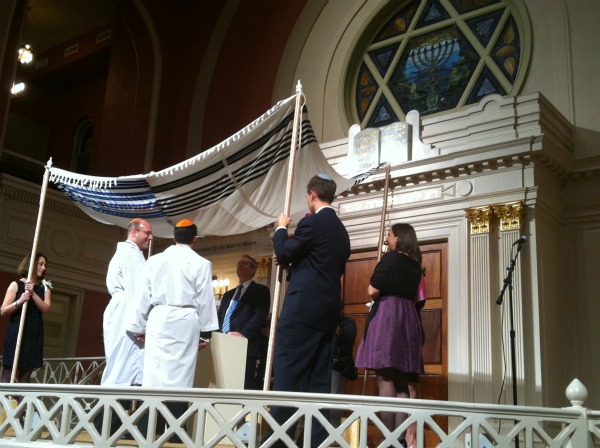
I don’t often like to think about the future. Instead, I like to study my past (hence my Jewish History major) and understand my present (hence my sociology major).
But when Commentary released its symposium wherein seventy professional Jews — academics, philosophers, researchers, and the like — were asked about what Judaism will look like in 2065, the answer was a resounding and ambivalent shrug. Some, to be sure, were more negative than others, claiming that Judaism and Jewish culture outside of Israel and those who cling to it will no longer exist, as Elliott Abrams surmised in the opening remarks of the symposium. Others, fearing the continued ascendancy of the Islamic State and the rise of anti-Semitism, see the future of Jews as downright bleak at best and utterly destroyed at worst.
And yet, when reading through these, one cannot help but wonder: How many of the people asked are LGBTQ? How many are intermarried? There are all growing segments of the Jewish community, but how many of those writers actually represent these growing factions within the Jewish world today, and how many will even be alive in 2065 to actually see what the Jewish world will look like?
I concede, as do many of the respondents, that I have no idea what the Jewish world will look like in 2065, when I reach the age of 70. However, I refuse to buy into the utter hysteria about the future evident in this symposium, the most recent wave of which began with the Pew Research Center’s “Portrait of Jewish Americans” study in 2013 and has persisted to this day, evidenced both by the fact that the study was referenced by many of the respondents and by the fact that I continue to return to it as well, two full years after its findings were released.
We must also critique the fact that many of these responses focus on macro-level problems — like the relationship between Israeli and Diaspora Jewry, or rising anti-Semitism — that have faced the Jewish community over the past fifty years and will, without a doubt, continue to face the Jewish community. The pessimistic approach to understanding the Jewish present (and thus the Jewish future) is one that inevitably spells doom. At the same time, it erases so much of the innovation coming out of the Jewish world today, and frees us — to our detriment — from the need to address some of the most pressing issues that we face today. If we continue to only look at the writing on the walls, then we don’t see so much of the vibrant present that we’ve created for ourselves. If we only see Judaism’s survival as contingent upon the survival of a Jewish national state, and deny the innovation that comes from the Diaspora, then we fail to understand the ways in which Judaism continues to flourish against all odds.
By writing off so many Jews today as doomed by assimilation, forever to be lost and lamented in the annals of history, we free ourselves from the responsibility to discuss and solve the problems posed by intermarriage, the pressing needs — which persist even in our most progressive Jewish communities—to fully engage LGBTQ Jews and their families, and to give non-Orthodox Jews a space in which to be creative and innovative in their Judaism. If we just write off those Jews who are intermarried, as an example, then they are lost, and we confirm what the data that we have been given already says. But if we choose to actually address the myriad of social and demographic problems facing us, as opposed to throwing our arms up in the air in desperation, then the Jewish world 50 years from now looks much brighter than Commentary would have us believe.
That is to say nothing of some of the amazing innovations which are happening right now in the Jewish world, many of which are occurring outside of Israel and can only happen in the Diaspora. We are seeing many challenges that come with engaging my generation of young Jews being met by providing online Jewish communal spaces (besides JSwipe), and establishing other communal gatherings that provide new and innovative spiritual opportunities for Jewish ritual and spiritual engagement, even if they take place outside of the traditional synagogue model.
My Judaism is anything but dying. My Judaism is one with a bright and important future, a future that is not going to be blurred by the threats of anti-Semitism. Mine is a Judaism that flourishes in the Diaspora, which continues to strive for innovation and change. Mine is one whose tent is ever widening because the people within it are constantly striving to expand it. Mine is the Judaism that struggles over the efficacy of the Shabbos switch and the Shabbos App alongside harder questions, like what our Jewish community can look like if we have rabbis who are intermarried.
Judaism is constantly on the change and on the move. It is not stagnant and it is not going to be relegated, as so many have suggested, to the past. We Jews are constantly changing and constantly causing our Judaism to evolve, but Judaism can only evolve if we continue to let it and push the envelope ever farther. Then, and only then, is our Judaism alive, and we will ensure that it will survive not only until 2065, but far into the future. I refuse to let it be any other way.
Amram Altzman is a student at List College.
